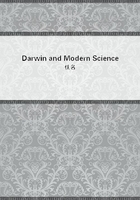
第304章
Making these assumptions, however, it is found that if each of the eclipsing stars were spherical it would not be possible to generate such a curve with the closest accuracy. The two stars are certainly close together, and it is obvious that in such a case the tidal forces exercised by each on the other must be such as to elongate the figure of each towards the other. Accordingly it is reasonable to adopt the hypothesis that the system consists of a pair of elongated ellipsoids, with their longest axes pointed towards one another. No supposition is adopted a priori as to the ratio of the two masses, or as to their relative size or brightness, and the orbit may have any degree of eccentricity. These last are all to be determined from the nature of the light-curve.
In the case of RR Centauri, however, Dr Roberts finds the conditions are best satisfied by supposing the orbit to be circular, and the sizes and masses of the components to be equal, while their luminosities are to one another in the ratio of 4 to 3. As to their shapes he finds them to be so much elongated that they overlap, as exhibited in his figure titled "The shape of the star RR Centauri" (Fig. 6.). The dotted curve shows a form of equilibrium of rotating liquid as computed by me some years before, and it was added for the sake of comparison.
On turning back to Fig. 5 the reader will see in the smooth dotted curve the light variation which would be exhibited by such a binary system as this. The curve is the result of computation and it is impossible not to be struck by the closeness of the coincidence with the series of black dots which denote the observations.
It is virtually certain that RR Centauri is a case of an eclipsing binary system, and that the two stars are close together. It is not of course proved that the figures of the stars are ellipsoids, but gravitation must deform them into a pair of elongated bodies, and, on the assumptions that they are not enveloped in an absorptive atmosphere and that they are ellipsoidal, their shapes must be as shown in the figure.
This light-curve gives an excellent illustration of what we have reason to believe to be a stage in the evolution of stars, when a single star is proceeding to separate into a binary one.
As the star is faint, there is as yet no direct spectroscopic evidence of orbital motion. Let us turn therefore to the case of another star, namely V Puppis, in which such evidence does already exist. I give an account of it, because it presents a peculiarly interesting confirmation of the correctness of the theory.
In 1895 Pickering announced in the "Harvard Circular" No. 14 that the spectroscopic observations at Arequipa proved V Puppis to be a double star with a period of 3d 2h 46m. Now when Roberts discussed its light-curve he found that the period was 1d 10h 54m 27s, and on account of this serious discrepancy he effected the reduction only on the simple assumption that the two stars were spherical, and thus obtained a fairly good representation of the light-curve. It appeared that the orbit was circular and that the two spheres were not quite in contact. Obviously if the stars had been assumed to be ellipsoids they would have been found to overlap, as was the case for RR Centauri. ("Astrophysical Journ." Vol. XIII. (1901), page 177.) The matter rested thus for some months until the spectroscopic evidence was re-examined by Miss Cannon on behalf of Professor Pickering, and we find in the notes on page 177 of Vol. XXVIII. of the "Annals of the Harvard Observatory" the following: "A.G.C. 10534. This star, which is the Algol variable V Puppis, has been found to be a spectroscopic binary.
The period 1d.454 (i.e. 1d 10h 54m) satisfies the observations of the changes in light, and of the varying separation of the lines of the spectrum. The spectrum has been examined on 61 plates, on 23 of which the lines are double." Thus we have valuable evidence in confirmation of the correctness of the conclusions drawn from the light-curve. In the circumstances, however, I have not thought it worth while to reproduce Dr Roberts's provisional figure.
I now turn to the conclusions drawn a few years previously by another observer, where we shall find the component stars not quite in contact.
This is the star Beta Lyrae which was observed by Goodricke, Argelander, Belopolsky, Schur, Markwick and by many others. The spectroscopic method has been successfully applied in this case, and the component stars are proved to move in an orbit about one another. In 1897, Mr. G.W. Myers applied the theory of eclipses to the light-curve, on the hypothesis that the stars are elongated ellipsoids, and he obtained the interesting results exhibited in Fig. 7. ("Astrophysical Journ." Vol. VII. (1898), page 1.)The period of Beta Lyrae is relatively long, being 12d 21h 47m, the orbit is sensibly eccentric, and the two spheroids are not so much elongated as was the case with RR Centauri. The mass of the system is enormous, one of the two stars being 10 times and the other 21 times as heavy as our sun.
Further illustrations of this subject might be given, but enough has been said to explain the nature of the conclusions which have been drawn from this class of observation.